Growth and Spectral Properties of Er3+ and Yb3+ Co-Doped Bismuth Silicate Single Crystal
Abstract
:1. Introduction
2. Experimental Procedures
3. Results and Discussion
3.1. Crystal Growth
3.2. Spectral Properties
3.2.1. Absorption Spectrum
3.2.2. Fluorescence Spectrum
3.3. Fluorescence Decay Curve and Fluorescence Lifetime
4. Conclusions
Author Contributions
Funding
Data Availability Statement
Conflicts of Interest
References
- Xu, J.Y.; Yang, B.B.; Zhang, Y. Development of doped Bi4Si3O12 crystals for scintillation, laser and LED applications. Mater. Focus 2015, 4, 20–27. [Google Scholar]
- Wang, P.; Dawes, J.M.; Burns, P.; Piper, J.A.; Zhang, H.J.; Zhu, L.; Meng, X.L. Diode-pumped cw Tunable Er3+: Yb3+: YCOB Laser at 1.5–1.6 μm. Opt. Mater. 2002, 19, 383–387. [Google Scholar] [CrossRef]
- Garbuzov, D.; Kudryashov, I.; Dubinskii, M. 110W (0.9J) Pulsed Power from Resonantly Diode-laser-pumped 1.6-μm Er: YAG Laser. Appl. Phys. Lett. 2005, 87, 1287. [Google Scholar] [CrossRef]
- Nizhankovskyi, S.V.; Kozlovskyi, A.A.; Kovalenko, N.O.; Vovk, O.O. Optical and luminescence properties of Er, Yb: YAG crystals grown by horizontal directional crystallization method. Funct. Mater. 2019, 26, 35–40. [Google Scholar] [CrossRef] [Green Version]
- Denker, B.; Galagan, B.; Ivleva, L.; Osiko, V.; Sverchkov, S.; Voronina, I.; Hellstrom, J.E.; Karlsson, G.; Laurell, F. New crystalline material for 1.5 μm lasers: Yb, Er-Activated GdCa4O(BO3)3. In Advanced Solid-State Photonics; Optica Publishing Group: Washington, DC, USA, 2004. [Google Scholar]
- Zhuang, R.Z.; Zhang, L.Z.; Lin, Z.B.; Wang, G.F. Growth and spectroscopic properties of Yb3+/ Er3+: CaMoO4 crystal. Mater. Res. Innov. 2010, 14, 306–311. [Google Scholar] [CrossRef]
- Zhong, D.G.; Teng, B.; Kong, W.J.; Zhang, S.M.; Li, Y.Y.; Li, J.H.; Yang, L.T.; Cao, L.F.; Smaalen, S.V. Growth, structure, defects and polarized absorption spectral properties of Er: Yb: YCa4O(BO3)3 crystals. J. Solid-State Chem. 2016, 233, 120–124. [Google Scholar] [CrossRef]
- Huang, J.H.; Chen, Y.J.; Wang, H.; Lin, Y.; Gong, X.H.; Luo, Z.D.; Huang, Y.D. Efficient 1620 nm continuous-wave laser operation of Czochralski grown Er: Yb: Lu2Si2O7 crystal. Opt. Express 2017, 25, 24001–24006. [Google Scholar] [CrossRef]
- Tsang, Y.H.; Binks, D.J. Record performance from a Q-switched Er3+: Yb3+: YVO4 laser. Appl. Phys. B 2009, 96, 11–17. [Google Scholar] [CrossRef]
- Xiao, X.F.; Xu, J.Y.; Xiang, W.D.; Wei, H.C.; Chu, Y.Q.; Yang, B.B.; Zhang, X.F. Optical and scintillation properties of Bi4Si3O12: Re (Re=Eu3+, Sm3+, Ho3+, Tb3+) single crystals. J. Rare Earth 2019, 37, 260–264. [Google Scholar] [CrossRef]
- Yang, B.B.; Xu, J.Y.; Zhang, Y.; Zeng, H.B.; Tian, T.; Chu, Y.Q.; Xiong, Z.Y.; Cui, Q.Z. Improvement and luminescent mechanism of Bi4Si3O12 scintillation crystals by Dy3+ doping. Nucl. Inst. Methods Phys. Res. A 2016, 807, 1–4. [Google Scholar] [CrossRef]
- Liu, H.; Kuo, C. Crystal structure of bismuth (III) silicate, Bi4(SiO4)3. Z. Krist. 1997, 212, 48. [Google Scholar]
- Xiao, X.F.; Xu, J.Y.; Xiang, W.D. Progress on scintillation crystals for dual-readout calorimeter. J. Inorg. Mater. 2013, 28, 247–357. [Google Scholar] [CrossRef]
- Shen, H.; Xu, J.Y.; Ping, W.J.; He, Q.B.; Zhang, Y.; Jin, M.; Jiang, G.J. Growth, Mechanical and Thermal Properties of Bi4Si3O12 Single Crystals. Chin. Phys. Lett. 2012, 29, 076501. [Google Scholar] [CrossRef]
- Xi, T.G.; Fei, Y.; Leung, W.P.; Choy, C.L. Thermal properties of bismuth germanate Bi4Ge3O12. J. Mater. Sci. Lett. 1989, 8, 1317–1319. [Google Scholar] [CrossRef]
- Cong, H.I.; Zhang, H.J.; Wang, J.Y.; Yu, W.T.; Fan, J.D.; Cheng, X.F.; Sun, S.Q.; Zhang, J.; Lu, Q.M.; Jiang, C.J.; et al. Structural and thermal properties of the monoclinic Lu2SiO5 single crystal: Evaluation as a new laser matrix. J. Appl. Cryst. 2009, 42, 284–294. [Google Scholar] [CrossRef]
- Wang, H.; Chen, Y.J.; Huang, J.H.; Gong, X.H.; Lin, Y.F.; Luo, Z.D.; Huang, Y.D. Spectroscopic properties and continuous-wave laser operation of Yb: Bi4Si3O12 crystal. Opt. Express 2014, 22, 21866–21871. [Google Scholar] [CrossRef]
- Lira, C.A.; Ramírez, M.O.; Solé, J.G.; Caldiño, U. Photoluminescence of Bi4Si3O12: Er3+ crystal excited in the commercial laser diode emission region. Opt. Mater. 2007, 29, 605–609. [Google Scholar] [CrossRef]
- Zhang, Y.; Gong, Z.; Duan, X.M.; Yuan, J.P.; Xu, J.Y.; Ma, Y.F.; Shen, Y.J. Growth, spectra and continuous-wave 2.1μm laser operation of a Ho3+-doped bismuth silicate crystal. CrystEngComm 2022, 24, 1590–1597. [Google Scholar] [CrossRef]
- Zhang, Y.; Huang, L.W.; Duan, X.M.; Gong, Z.; Tian, T.; Ma, Y.F.; Xu, J.Y. Tm3+: Bi4Si3O12 crystal as a promising laser material near 2 μm: Growth, spectroscopic properties and laser performance. Opt. Express 2021, 29, 29138–29148. [Google Scholar] [CrossRef]
- Xu, J.Y.; Li, Z.C.; Pan, Y.F.; Zhou, D.; Wen, F.; MA, W.J. Research progress of Hyperstoichiometric UO2 crystals. J. Inorg. Mater. 2020, 35, 183–192. [Google Scholar]
- Zhang, Y.; Xu, J.Y.; Cui, Q.Z.; Yang, B.B. Eu3+-doped Bi4Si3O12 red phosphor for solid state lighting: Microwave synthesis, characterization, photoluminescence properties and thermal quenching mechanisms. Sci. Rep. 2017, 7, 42464. [Google Scholar] [CrossRef] [PubMed] [Green Version]
- Xu, J.Y.; Wang, H.; He, Q.B.; Shen, H.; Hajime, S.; Xiang, W.D. Bridgman growth of Bi4Si3O12 scintillation crystals. J. Chin. Ceram. Soc. 2009, 37, 295–298. [Google Scholar]
- Xu, J.Y.; Wang, J.; Chen, W.; Xiao, X.F.; Yang, B.B.; Wang, Z.Y.; Li, F.; Xie, H.D. Synthesis, growth and scintillation properties of large size Bi4Si3O12 crystals. J. Inorg. Mater. 2016, 31, 1147–1150. [Google Scholar]
- Fei, Y.T.; Fan, S.J.; Sun, R.Y.; Xu, J.Y. Crystallizing behavior of Bi2O3-SiO2 system. J. Mater. Sci. Lett. 2000, 19, 893–895. [Google Scholar] [CrossRef]
- Xu, J.Y.; Feng, H.W.; Pan, Y.F.; Zhang, Y.; Fan, S.J. Development of bismuth silicate scintillation crystals and doping effects. J. Chin. Ceram. Soc. 2017, 45, 1748–1757. [Google Scholar]
- Lira, C.A.; Camarillo, I.; Camarillo, E.; Ramos, F.; Flores, M.; Caldiño, U. Spectroscopic characterization of Er3+ transitions in Bi4Si3O12. J. Phys. Condens. Matter. 2004, 16, 5925–5936. [Google Scholar]
- Cantelar, E.; Nevado, R.; Martín, G.; Sanz-Garcia, J.A.; Lifante, G.; Cusso, F.; Hernandez, M.J.; Pernas, P.L. Optical properties of Er and Yb co-doped lithium niobate waveguides. J. Lumin. 2000, 87–89, 1096–1098. [Google Scholar] [CrossRef]
- Zhao, D.; Hu, Z.S.; Lin, Z.B.; Wang, G.F. Growth and spectral properties of Er3+/Yb3+-codoped Sr3Y(BO3)3 crystal. J. Cryst. Growth 2005, 277, 401–405. [Google Scholar] [CrossRef]
- Tsuboi, T. Emission spectroscopy of Er3+/Yb3+-codoped YVO4 crystals. Phys. B 2000, 293, 84–90. [Google Scholar] [CrossRef]
- Schweizer, T.; Jensen, T.; Heumann, E.; Huber, G. Spectroscopic properties and diode pumped 1.6μm laser performance in Yb-codoped Er: Y3Al5O12 and Er: Y2SiO5. Opt. Commun. 1995, 118, 557–561. [Google Scholar] [CrossRef]
- Tolstik, N.A.; Troshin, A.E.; Kisel, V.E.; Kuleshov, N.V.; Matrosov, V.N.; Matrosova, T.A.; Kupchenko, M.I. Spectroscopy and continuous-wave diode-pumped laser operation of Er3+, Yb3+: YVO4 single crystal. In Advanced Solid-State Photonics; Optica Publishing Group: Washington, DC, USA, 2006. [Google Scholar]
- Jaffrès, A.; Loiseau, P.; Aka, G.; Viana, B.; Larat, C.; Lallier, E. CW diode pumped Er, Yb, Ce: CAS single crystal 1.5 μm laser. Laser Phys. 2014, 24, 125801. [Google Scholar] [CrossRef]
- Burns, P.A.; Dawes, J.M.; Dekker, P.; Piper, J.A.; Jiang, H.D.; Wang, J.Y. Optimization of Er, Yb: YCOB for CW laser operation. IEEE J. Quantum Electron. 2004, 40, 1575–1582. [Google Scholar] [CrossRef]
- Tolstik, N.A.; Kurilchik, S.V.; Kisel, V.E.; Kuleshov, N.V.; Maltsev, V.V.; Pilipenko, O.V.; Koporulina, E.V.; Leonyuk, N.I. Efficient 1W continuous-wave diode-pumped Er, Yb: YAl3(BO3)4 laser. Opt. Lett. 2007, 32, 3233–3235. [Google Scholar] [CrossRef] [Green Version]
- Wang, Y.M.; Liu, J.H.; Zhang, L.J.; Li, J.L.; Zeng, F.M.; Wan, Y.C.; Zhang, L. Properties of Er3+/Yb3+:KY(WO4)2 crystal grown by TSSG method. Rare Met. Mater. Eng. 2006, 35, 1504–1508. [Google Scholar]
- Kuleshov, N.V.; Lagatsky, A.A.; Podlipensky, A.V.; Mikhailov, V.P.; Kornienko, A.A.; Dunina, E.B.; Hartung, S.; Huber, G. Fluorescence dynamics, excited-state absorption, and stimulated emission of Er3+ in KY(WO4)2. J. Opt. Soc. Am. B-Opt. Phys 1998, 15, 1205–1212. [Google Scholar] [CrossRef]
- Laporta, P.; Taccheo, S.; Longhi, S.; Svelto, O.; Svelto, C. Erbium–ytterbium microlasers: Optical properties and lasing characteristics. Opt. Mater. 1999, 11, 269–288. [Google Scholar] [CrossRef]


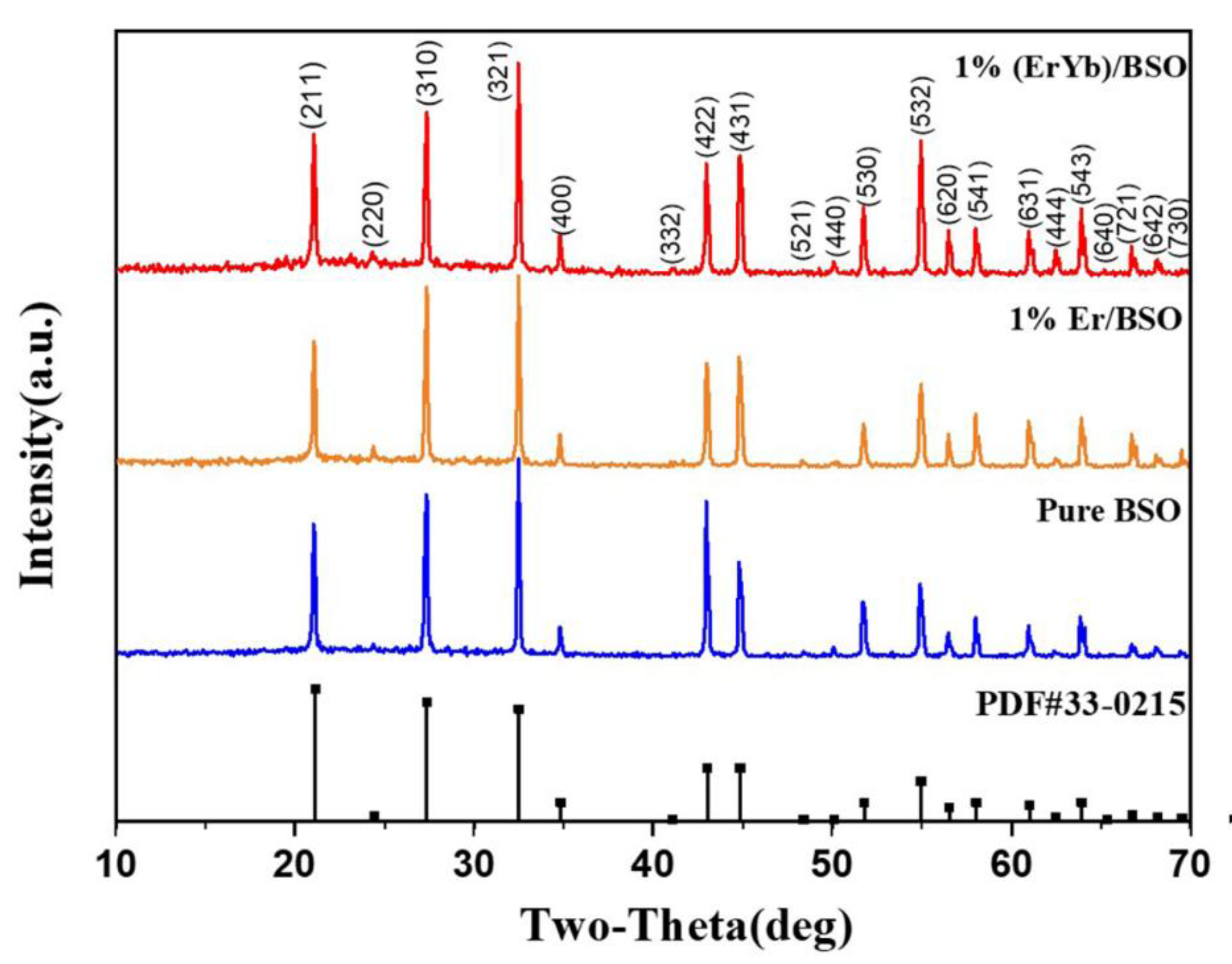
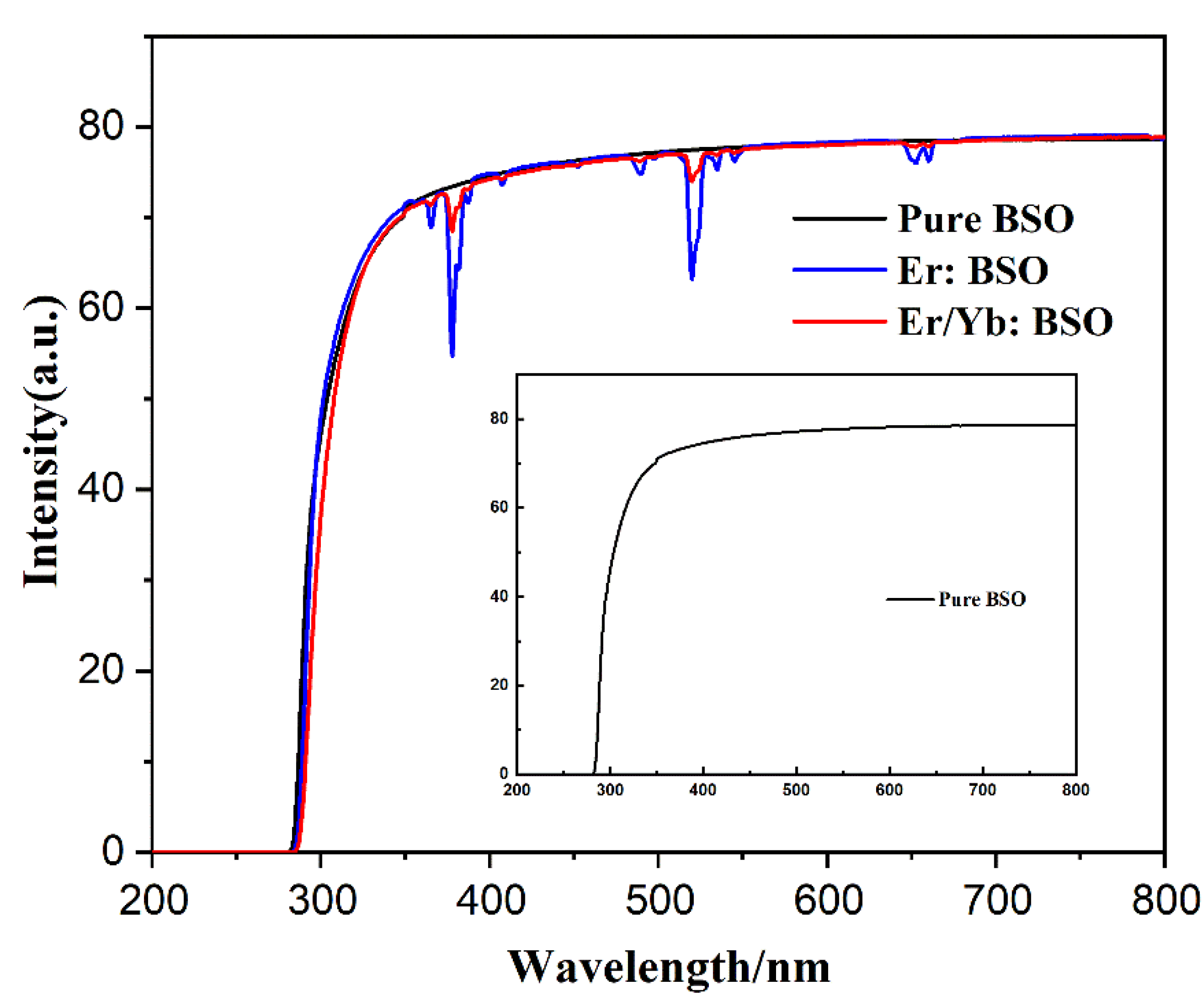
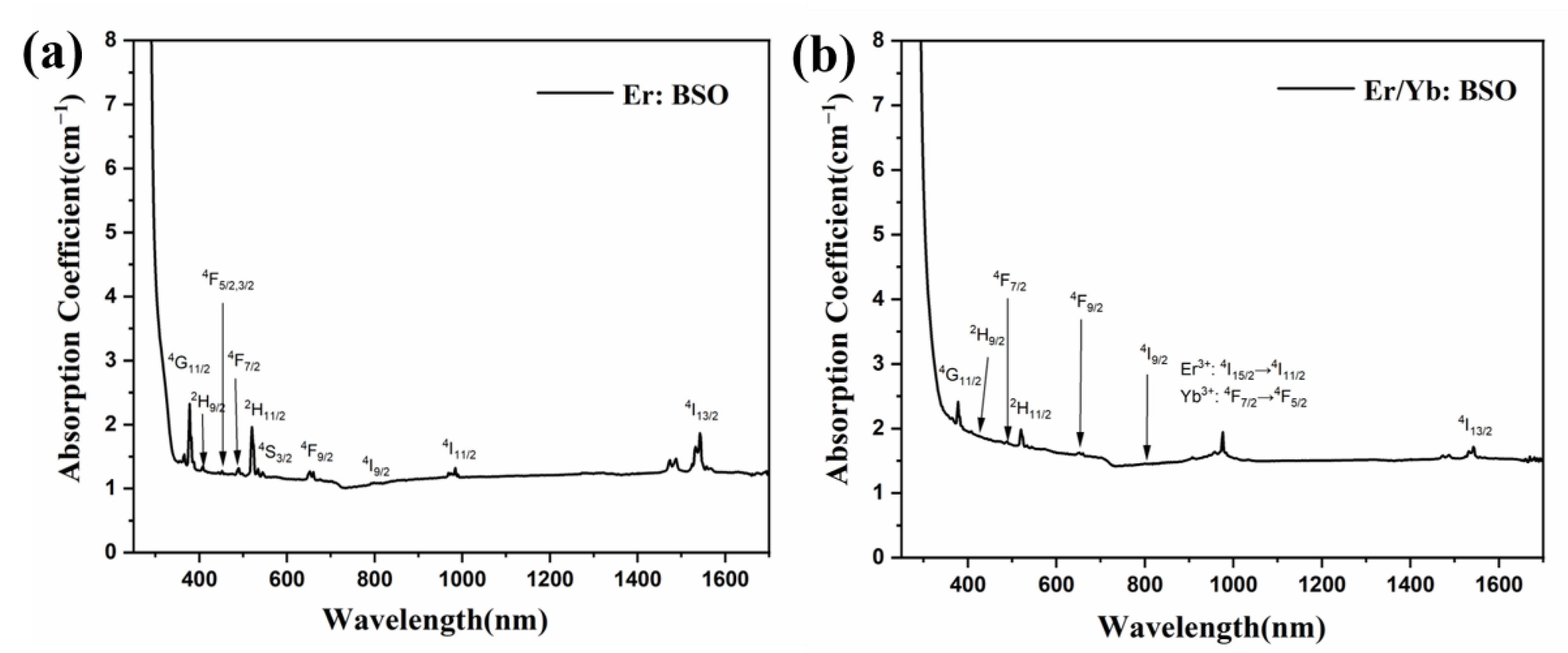

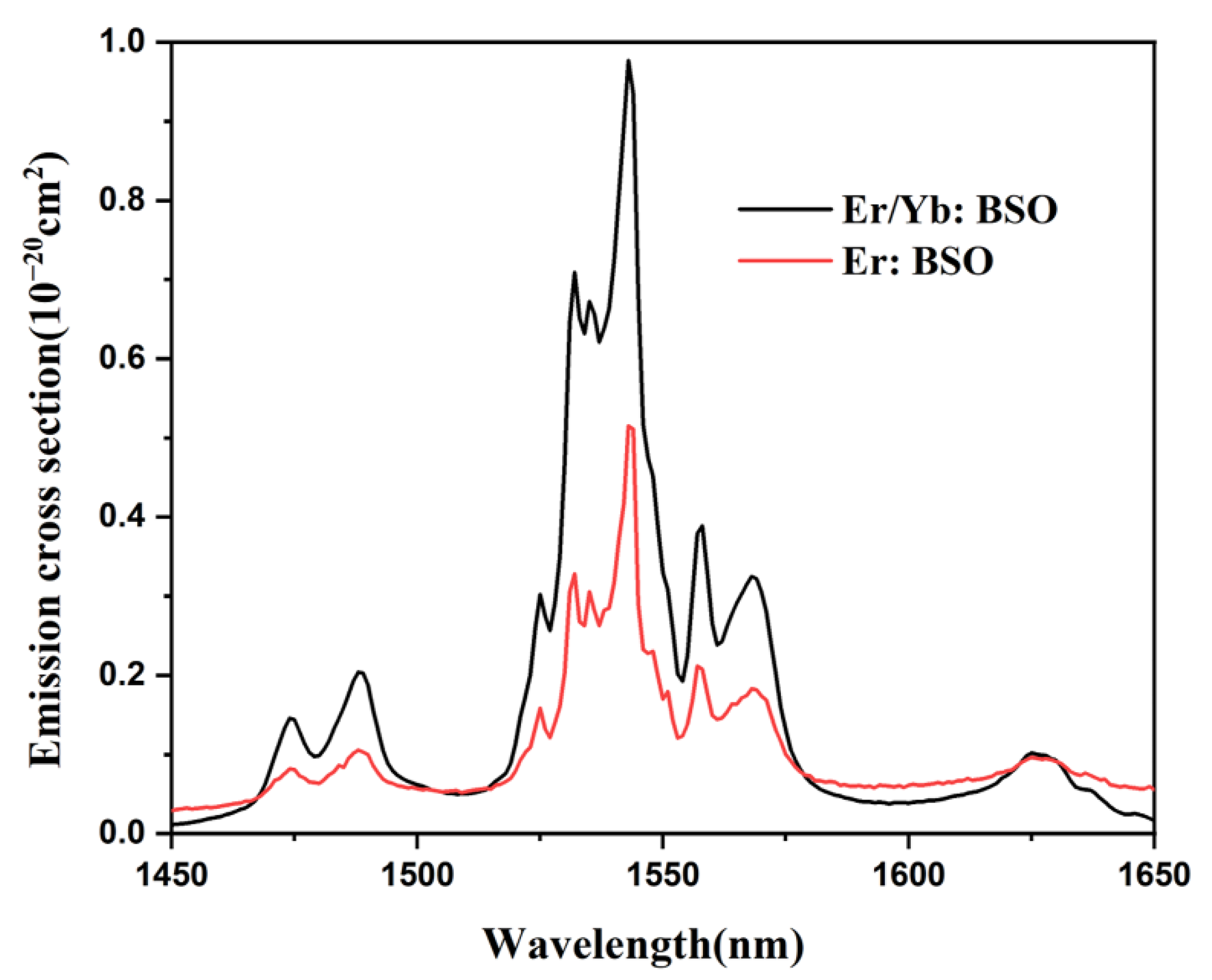
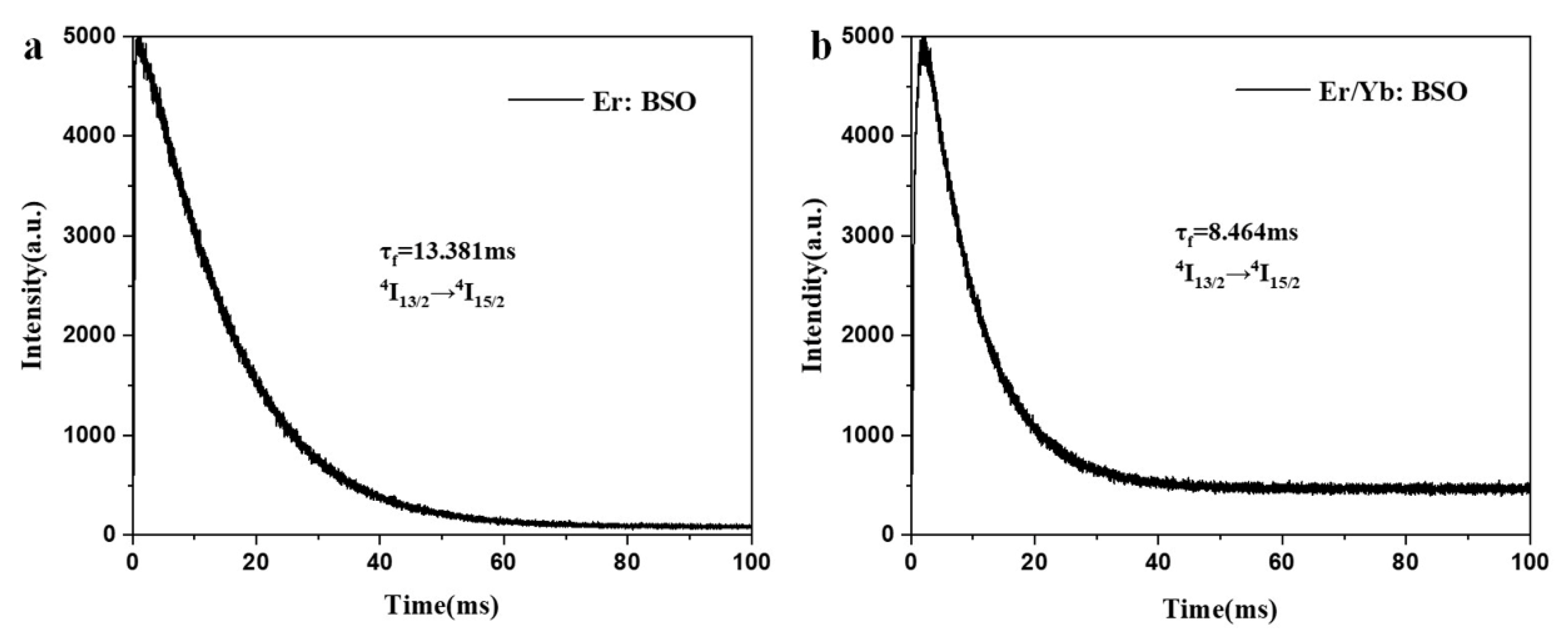
| Name | Purity | Company Name | City, Country |
|---|---|---|---|
| Bi2O3 | 5N | Jincheng Reagent Co., Ltd. | Kunshan, China |
| SiO2 | 4N | Shanghai Boer Chemical Reagent Co., Ltd. | Shanghai, China |
| Er2O3 | 4N | Sinopharm Chemical Reagent Co., Ltd. | Shanghai, China |
| Yb2O3 | 4N | Sinopharm Chemical Reagent Co., Ltd. | Shanghai, China |
| K (W∙m−1K−1) | σα (10−20 cm2) at 980 nm | σem (10−20 cm2) at 1.5 μm | τ (ms) at 1.5 μm | |
|---|---|---|---|---|
| BSO | 3.29 | 6.96 | 0.9771 | 8.464 |
| Lu2Si2O7 [8] | 14.28 | 0.8 E//X 1.12 E//Y 0.76 E//Z | 0.85 E//X 1.2 E//Y 0.81 E//Z | 8.6 |
| YCOB [34] | 2.7 | 0.9 | 0.6 | 1.25 |
| YAB [35] | 4.7 | 2.75 | 2.5 | 0.33 |
| KYW [36,37] | 2.7 | 3.2 | 2.5 | 4.8 |
| YAG [31] | 14 | 0.9 | 1.5 | 7.7 |
| YVO4 [9,32] | 9.6 | 8 | 0.7 | 2.3 |
| Glass [38] | 0.8 | 1.4 | 0.8 | 8 |
Publisher’s Note: MDPI stays neutral with regard to jurisdictional claims in published maps and institutional affiliations. |
© 2022 by the authors. Licensee MDPI, Basel, Switzerland. This article is an open access article distributed under the terms and conditions of the Creative Commons Attribution (CC BY) license (https://creativecommons.org/licenses/by/4.0/).
Share and Cite
Zhang, Y.; Hu, S.; Tian, T.; Xiao, X.; Chen, Y.; Zhang, Y.; Xu, J. Growth and Spectral Properties of Er3+ and Yb3+ Co-Doped Bismuth Silicate Single Crystal. Crystals 2022, 12, 1532. https://doi.org/10.3390/cryst12111532
Zhang Y, Hu S, Tian T, Xiao X, Chen Y, Zhang Y, Xu J. Growth and Spectral Properties of Er3+ and Yb3+ Co-Doped Bismuth Silicate Single Crystal. Crystals. 2022; 12(11):1532. https://doi.org/10.3390/cryst12111532
Chicago/Turabian StyleZhang, Yan, Shucheng Hu, Tian Tian, Xuefeng Xiao, Yuanzhi Chen, Yan Zhang, and Jiayue Xu. 2022. "Growth and Spectral Properties of Er3+ and Yb3+ Co-Doped Bismuth Silicate Single Crystal" Crystals 12, no. 11: 1532. https://doi.org/10.3390/cryst12111532
APA StyleZhang, Y., Hu, S., Tian, T., Xiao, X., Chen, Y., Zhang, Y., & Xu, J. (2022). Growth and Spectral Properties of Er3+ and Yb3+ Co-Doped Bismuth Silicate Single Crystal. Crystals, 12(11), 1532. https://doi.org/10.3390/cryst12111532








